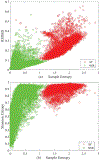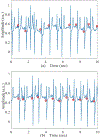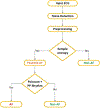Atrial Fibrillation Detection During Sepsis: Study on MIMIC III ICU Data
- PMID: 32750900
- PMCID: PMC7670858
- DOI: 10.1109/JBHI.2020.2995139
Atrial Fibrillation Detection During Sepsis: Study on MIMIC III ICU Data
Abstract
Sepsis is defined by life-threatening organ dysfunction during infection and is one of the leading causes of critical illness. During sepsis, there is high risk that new-onset of atrial fibrillation (AF) can occur, which is associated with significant morbidity and mortality. As a result, computer aided automated and reliable detection of new-onset AF during sepsis is crucial, especially for the critically ill patients in the intensive care unit (ICU). In this paper, a novel automated and robust two-step algorithm to detect AF from ICU patients using electrocardiogram (ECG) signals is presented. First, several statistical parameters including root mean square of successive differences, Shannon entropy, and sample entropy were calculated from the heart rate for the screening of possible AF segments. Next, Poincaré plot-based features along with P-wave characteristics were used to reduce false positive detection of AF, caused by the premature atrial and ventricular beats. A subset of the Medical Information Mart for Intensive Care (MIMIC) III database containing 198 subjects was used in this study. During the training and validation phases, both the simple thresholding as well as machine learning classifiers achieved very high segment-wise AF classification performance. Finally, we tested the performance of our proposed algorithm using two independent test data sets and compared the performance with two state-of-the-art methods. The algorithm achieved an overall 100% sensitivity, 98% specificity, 98.99% accuracy, 98% positive predictive value, and 100% negative predictive value on the subject-wise AF detection, thus showing the efficacy of our proposed algorithm in critically ill sepsis patients. The annotations of the data have been made publicly available for other investigators.
Figures








Similar articles
-
Development and Validation of an Automated Algorithm to Detect Atrial Fibrillation Within Stored Intensive Care Unit Continuous Electrocardiographic Data: Observational Study.JMIR Cardio. 2021 Feb 15;5(1):e18840. doi: 10.2196/18840. JMIR Cardio. 2021. PMID: 33587041 Free PMC article.
-
Novel Density Poincaré Plot Based Machine Learning Method to Detect Atrial Fibrillation From Premature Atrial/Ventricular Contractions.IEEE Trans Biomed Eng. 2021 Feb;68(2):448-460. doi: 10.1109/TBME.2020.3004310. Epub 2021 Jan 20. IEEE Trans Biomed Eng. 2021. PMID: 32746035 Free PMC article.
-
Atrial Fibrillation Prediction from Critically Ill Sepsis Patients.Biosensors (Basel). 2021 Aug 9;11(8):269. doi: 10.3390/bios11080269. Biosensors (Basel). 2021. PMID: 34436071 Free PMC article.
-
Atrial Fibrillation Detection in ICU Patients: A Pilot Study on MIMIC III Data.Annu Int Conf IEEE Eng Med Biol Soc. 2019 Jul;2019:298-301. doi: 10.1109/EMBC.2019.8856496. Annu Int Conf IEEE Eng Med Biol Soc. 2019. PMID: 31945900
-
Preliminary Results on Density Poincare Plot Based Atrial Fibrillation Detection from Premature Atrial/Ventricular Contractions.Annu Int Conf IEEE Eng Med Biol Soc. 2020 Jul;2020:2594-2597. doi: 10.1109/EMBC44109.2020.9175216. Annu Int Conf IEEE Eng Med Biol Soc. 2020. PMID: 33018537
Cited by
-
Optimized Signal Quality Assessment for Photoplethysmogram Signals Using Feature Selection.IEEE Trans Biomed Eng. 2022 Sep;69(9):2982-2993. doi: 10.1109/TBME.2022.3158582. Epub 2022 Aug 19. IEEE Trans Biomed Eng. 2022. PMID: 35275809 Free PMC article.
-
Fibrinaloid Microclots and Atrial Fibrillation.Biomedicines. 2024 Apr 17;12(4):891. doi: 10.3390/biomedicines12040891. Biomedicines. 2024. PMID: 38672245 Free PMC article. Review.
-
Development and Validation of an Automated Algorithm to Detect Atrial Fibrillation Within Stored Intensive Care Unit Continuous Electrocardiographic Data: Observational Study.JMIR Cardio. 2021 Feb 15;5(1):e18840. doi: 10.2196/18840. JMIR Cardio. 2021. PMID: 33587041 Free PMC article.
-
Quantifying deep neural network uncertainty for atrial fibrillation detection with limited labels.Sci Rep. 2022 Nov 22;12(1):20140. doi: 10.1038/s41598-022-24574-y. Sci Rep. 2022. PMID: 36418604 Free PMC article.
-
Novel Density Poincaré Plot Based Machine Learning Method to Detect Atrial Fibrillation From Premature Atrial/Ventricular Contractions.IEEE Trans Biomed Eng. 2021 Feb;68(2):448-460. doi: 10.1109/TBME.2020.3004310. Epub 2021 Jan 20. IEEE Trans Biomed Eng. 2021. PMID: 32746035 Free PMC article.
References
-
- Hershey TB and Kahn JM, “State sepsis mandates-a new era for regulation of hospital quality.” The New England journal of medicine, vol. 376, no. 24, p. 2311, 2017. - PubMed
Publication types
MeSH terms
Grants and funding
LinkOut - more resources
Full Text Sources
Medical
Research Materials

